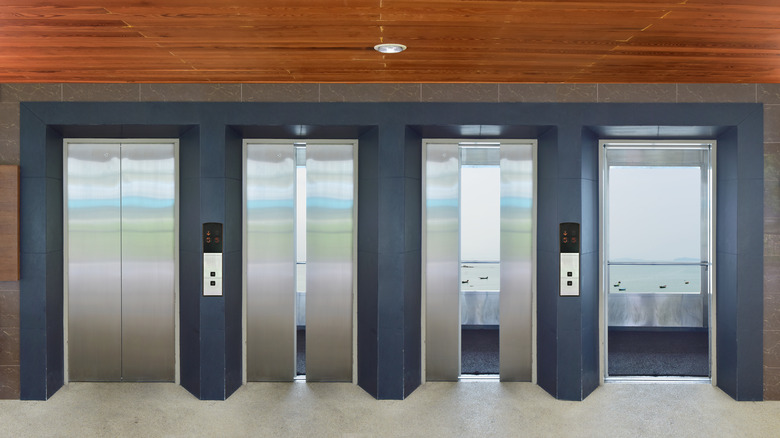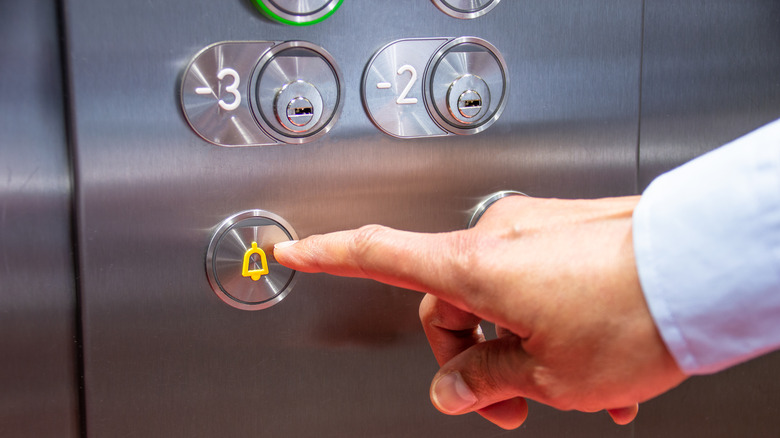This Is How Likely You Are To Die In An Elevator Accident
Hearing stories of accidents involving elevators can trigger a fear of using one, and it's highly understandable. There isn't a specific term for the fear of riding elevators, but according to Very Well Mind, a percentage of passengers experience slight to severe nervousness when the need to ride an elevator arises. The fear may be triggered by claustrophobia or agoraphobia, or perhaps it can be the result of reading reports about elevator accidents that, in some cases, result in death.
In 2011, a school administrator from New Jersey shared his experience to ABC News about being trapped in an elevator with 34 other people. "It was amazing how quickly the fear spread, and people were definitely breathing heavily and you could hear the tension rising in their voices," he said. According to medical experts, approximately 2% of the population has situation-specific phobias, such as the fear of riding elevators. But are elevator accidents really that common? And how many of those accidents result in death?
Elevator accident statistics
According to a report by Insider, elevator accidents are not as common as one might think. On average, approximately 10,000 elevator accidents result in injuries, and about 27 of those result in death. That number, however, pertains to workers who install, maintain, or repair elevators. When it comes to passengers, reports show an average of five deaths per year out of more than 18 billion elevator trips.
With that said, you are more likely to die in other situations than in an elevator accident. Per Elevator Injury Lawyer, there is a higher chance of dying in a car accident, shark attack, or plane crash than in an elevator. Surprisingly, even dying by a lightning strike is more likely than an elevator death. As the report indicated, there is a .0000000958% chance of you dying in an elevator. Nevertheless, elevator deaths still happen, but they are preventable most of the time with proper maintenance.
Common elevator accidents
In 2011, a 41-year-old woman died in an elevator mishap in New York. As reported by ABC News, the woman was on the first floor of her work building and was headed to the floor of her office on a higher level when the elevator malfunctioned and closed abruptly as she entered. The doors closed on her, and she was pulled up as the elevator ascended. In another incident in New York, a 30-year-old man died when he was crushed by a falling elevator (via Insider). However, these freak accidents are extremely rare, and as mentioned before, a majority of elevator deaths happen to repair and maintenance workers.
The Electronic Library of Construction Occupational Safety & Health or ELCOSH, has compiled a list of elevator-related deaths that occurred between 1992 and 2003. According to the information they provided, most of the 93 deaths were a result of a fall or being caught in the shaft. 70% of those who died were elevator repairers and installers, and the report further noted that 10 of the 93 were not certified to work on elevators.
Elevators are safer than stairs
Elevators are equipped with safety mechanisms that prevent accidents and deaths. They are typically held by between six to eight steel cables, which is more than the required number for safety. Furthermore, each cable is able to hold more than the weight of the shaft, so even if some cables snap, the elevator won't fall, as explained by Science ABC. Elevators also have safety brakes that stop them from plummeting down at an unsafe speed in the event the steel cables give out. The safety brake slows the elevator down to prevent passengers from getting injured.
In a report published by Reuters, over 1 million people get injured each year while using the stairs. According to information gathered by researchers in the span of 23 years, emergency rooms in hospitals treated 25 million patients who had accidents on stairs. That number translates to approximately 3,000 injuries related to stairs in a day. Data gathered by the National Center for Health Statistics also showed that about 1,600 people die yearly from falling down a flight of stairs, which is higher than the rate of elevator deaths (via Live Science), making elevators safer than stairs.



